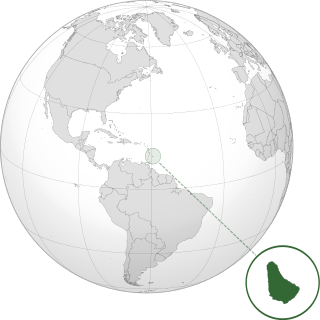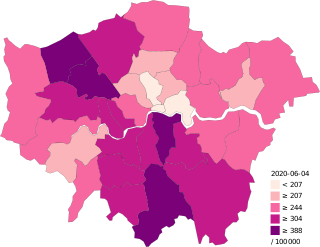St. Vincent Medical Center (SVMC) is a hospital in the Westlake neighborhood of Los Angeles, California, United States. Started by the Daughters of Charity in 1856, the hospital closed on January 24, 2020, due to the bankruptcy of Verity Health System.

The COVID-19 pandemic in Malaysia was a part of the ongoing worldwide pandemic of coronavirus disease 2019 caused by severe acute respiratory syndrome coronavirus 2. As of 10 February 2023, with over 5 million confirmed COVID-19 cases, a high of approximately 323,000 active cases, nearly 40,000 deaths, and over 66 million tests, the country is currently ranked third in the number of COVID-19 cases in Southeast Asia behind Vietnam and Indonesia, and fourth in the number of COVID-19 deaths in Southeast Asia behind Indonesia, the Philippines, and Vietnam.

The COVID-19 pandemic in Thailand has a part of the worldwide pandemic of coronavirus disease 2019 caused by severe acute respiratory syndrome coronavirus 2. Thailand was the first country to report a case outside China, on 13 January 2020. As of 2 April 2022, the country has reported a cumulative total of 3,684,755 confirmed cases, with 25,318 deaths from the disease, and currently ranked fourth in the number of cases in Southeast Asia, behind Vietnam, Indonesia, and Malaysia.

In the United States, the worldwide pandemic of coronavirus disease 2019 (COVID-19) caused by severe acute respiratory syndrome coronavirus 2 (SARS-CoV-2) has resulted in 103,436,829 confirmed cases with 1,127,152 all-time deaths, the most of any country, and the 20th-highest per capita worldwide. The COVID-19 pandemic ranks first on the list of disasters in the United States by death toll; it was the third-leading cause of death in the U.S. in 2020, behind heart disease and cancer. From 2019 to 2020, U.S. life expectancy dropped by 3 years for Hispanic and Latino Americans, 2.9 years for African Americans, and 1.2 years for white Americans. These effects persisted as U.S. deaths due to COVID-19 in 2021 exceeded those in 2020, and life expectancy continued to fall from 2020 to 2021.

The COVID-19 pandemic in Pakistan was a part of the ongoing pandemic of coronavirus disease 2019 caused by severe acute respiratory syndrome coronavirus 2. The virus was confirmed to have reached Pakistan on 26 February 2020, when two cases were recorded. On 18 March 2020, cases had been registered in all four provinces, the two autonomous territories, and Islamabad Capital Territory, and by 17 June, each district in Pakistan had recorded at least one confirmed case of COVID-19.

The first confirmed case relating to the COVID-19 pandemic in the United States was announced by the state of Washington on January 21, 2020. Washington made the first announcement of a death from the disease in the U.S. on February 29 and later announced that two deaths there on February 26 were also due to COVID-19. Until mid-March, Washington had the highest absolute number of confirmed cases and the highest number per capita of any state in the country, until it was surpassed by New York state on April 10, 2020. Many of the deceased were residents of a nursing home in Kirkland, an Eastside suburb of Seattle in King County.

The COVID-19 pandemic in Metro Manila was a part of the worldwide pandemic of coronavirus disease 2019 caused by severe acute respiratory syndrome coronavirus 2. The virus reached Metro Manila on January 30, 2020, when the first case of COVID-19 in the Philippines was confirmed in Manila. Metro Manila is the worst affected region in the Philippines, where most cases in the country are recorded. A state of calamity and community quarantine was declared in the region on March 15.

The COVID-19 pandemic was confirmed to have reached the U.S. state of Arizona in January 2020. As of June 3, 2021 Arizona public health authorities reported 322 new cases of COVID-19 and five deaths, bringing the cumulative totals since the start of the pandemic to 882,691 cases and 17,653 deaths. 12.3% of the state's population has been positively diagnosed with COVID-19 since the first case was reported on January 26, 2020.

The COVID-19 pandemic in the U.S. state of Vermont is part of an ongoing worldwide viral pandemic of coronavirus disease 2019, a novel infectious disease caused by severe acute respiratory syndrome coronavirus 2.

The COVID-19 pandemic in Ontario was a viral pandemic of coronavirus disease 2019 (COVID-19), a novel infectious disease caused by severe acute respiratory syndrome coronavirus 2 (SARS-CoV-2). The first confirmed case of COVID-19 in Canada was announced on January 25, 2020, involving a traveller who had recently returned to Toronto from travel in China, including Wuhan. Ontario has had the largest number of confirmed COVID-19 cases among Canada's provinces and territories, but due to having the largest population, only ranks sixth adjusted per capita. Ontario surpassed one million lab-confirmed COVID-19 cases on January 24, 2022; one day before the anniversary of the first confirmed case on January 25, 2020.

The COVID-19 pandemic in Barbados was a part of the ongoing COVID-19 pandemic of coronavirus disease 2019 (COVID-19). The outbreak was identified in Wuhan, Hubei, China, in December 2019, declared to be a Public Health Emergency of International Concern on 30 January 2020, and recognized as a pandemic by the World Health Organization on 11 March 2020. COVID-19 is an infectious disease caused by severe acute respiratory syndrome coronavirus 2 (SARS-CoV-2). The case fatality rate for COVID-19 has been much lower than for other coronavirus respiratory infections such as SARS and MERS, but the transmission has been significantly greater, with a significant total death toll.

The first case relating to the COVID-19 pandemic in London, England, was confirmed on 12 February 2020 in a woman who had recently arrived from China. By March 2020, there had been almost 500 confirmed cases in the city, and 23 deaths; a month later, the number of deaths had topped 4,000.

Operation Rescript was the code name for the British military operation to help tackle the COVID-19 pandemic in the United Kingdom and its Crown Dependencies between 2020 and 2022. It was described as the UK's "biggest ever homeland military operation in peacetime" by the Ministry of Defence (MOD), involving up to 23,000 personnel within a specialist task force, named the COVID Support Force (CSF). The support was given at the request of the UK government, its devolved administrations and civil authorities through the Military aid to the civil authorities (MACA) mechanism.

The NHS Nightingale Hospital London was the first of the NHS Nightingale Hospitals, temporary hospitals set up by NHS England for the COVID-19 pandemic. It was housed in the ExCeL London convention centre in East London. The hospital was rapidly planned and constructed, being formally opened on 3 April and receiving its first patients on 7 April 2020. It served 54 patients during the first wave of the pandemic, and was used to serve non-COVID patients and provide vaccinations during the second wave. It was closed in April 2021.
COVID-19 hospitalsin the United Kingdom are temporary hospitals set up in the United Kingdom and overseas territories as part of the response to the COVID-19 pandemic.

The NHS Louisa Jordan was a temporary emergency critical care hospital created to deal with the COVID-19 pandemic in Scotland. It was located within the SEC Centre in Glasgow.
The National Public Health Emergency Team for COVID-19 (NPHET) was a National Public Health Emergency Team within Ireland's Department of Health that oversaw and provided national direction, support, guidance and expert advice on developing and implementing a strategy to control the coronavirus disease 2019 (COVID-19) pandemic in Ireland.

The Hospital El Salvador is a major hospital in San Salvador, El Salvador, which was planned to be the largest hospital in Latin America. The first phase was constructed between March and June 2020 as a conversion of the International Fair and Convention Center and formed part of El Salvador's response to the COVID-19 pandemic, exclusively receiving COVID-19 patients. Originally intended to be temporary, it was announced in June 2020 that the hospital conversion would be made permanent. In its first phase, the hospital has 400 available beds, a number which was expected to increase to 2,000 total beds upon completion of phase 3 of construction. However, phase 3 was not opened as a hospital and instead served as a vaccination facility. With the decline of the pandemic, the facility has been announced as the home for a new medical school and also houses offices for the Salvadoran health ministry.

COVID-19 hospital is a general name given to clinical institutions that provide medical treatment to Coronavirus Disease 2019 (COVID-19) infected patients. According to the World Health Organisation (WHO)'s COVID-19 regulations, it is critical to distribute COVID-19 patients to different medical institutions based on their severity of symptoms and the medical resource availability in different geographical regions. It is recommended by the WHO to distribute patients with the most severe symptoms to the most equipped, COVID-19 focused hospitals, then patients with less severe symptoms to local institutions and lastly, patients with light symptoms to temporary COVID-19 establishments for appropriate isolation and monitoring of disease progression. Countries, like China, Germany, Russia, the United Kingdom and the United States have established their distinctive COVID-19 clinical set-ups based on the general WHO guidelines. Future pandemic protocols have also been adapted based on handling COVID-19 on a national and global scale.
The COVID-19 pandemic in the Australian Capital Territory is part of the ongoing worldwide pandemic of the coronavirus disease 2019 caused by severe acute respiratory syndrome coronavirus 2. After one case of the delta variant in mid-August 2021, the Territory went into lockdown. By 26 September, the ACT had its first COVID-19 related death since mid-April 2020, nearly 18 months, followed by 3 more deaths in the first week of October 2021. 28 deaths during the outbreak since 12 August 2021 brought total deaths to 31, the most recent being on 8 February 2022.


















